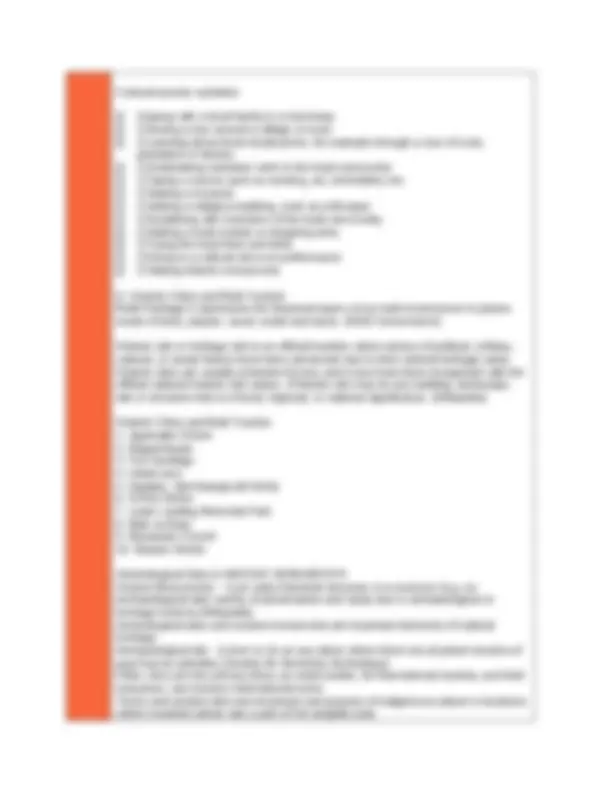





Study with the several resources on Docsity

Earn points by helping other students or get them with a premium plan


Prepare for your exams
Study with the several resources on Docsity

Earn points to download
Earn points by helping other students or get them with a premium plan
Community
Ask the community for help and clear up your study doubts
Discover the best universities in your country according to Docsity users
Free resources
Download our free guides on studying techniques, anxiety management strategies, and thesis advice from Docsity tutors
A module from the College of Tourism and Hospitality Management at the University of Makati. It introduces students to the context behind heritage products and elaborates on different heritage destination attractions. The document covers topics such as religious tourism, diaspora tourism, living culture, archeological sites, and industrial tourism. It also discusses the tangible and intangible attractions of heritage destinations and how they cater to the needs of travelers in learning different cultures and history of the past. a list of the world's most popular religious destinations and different types of archeological materials.
Typology: Lecture notes
1 / 6

This page cannot be seen from the preview
Don't miss anything!




J. P. Rizal Ext., West Rembo, Makati City COLLEGE OF TOURISM AND HOSPITALITY MANAGEMENT Course Title Module No.
Title Subject Heritage Tourism products HERITAGE TOURISM Timeframe: WEEK 3 INTRODUCTIO
This subject introduces students about the context behind heritage products. It focuses as well on the illustration and elaboration of the different heritage destination attractions.This topic could also involves understandings on the various facet of the heritage products. LEARNING COUTCOMES At the end of the discussion the students will be able to:
Heritage Tourism products Entails with the tangible and intangible attractions of the destinations that caters the needs of travellers in learning different cultures and history of the past. it is composed of natural, cultural and man-made resources, attractions, facilities, services and activities within the destination area. Heritage Tourism products A. Religious Tourism B. Diapora Tourism C. Living Culture D. Historic Cities and Build Tourism E. Archeological Sites and Ancient Monuments F. Industrial Tourism A. Religious Tourism Is one of the most prevalent forms of heritage tourism in the developing world today and is among the earliest precursors of modern day tourism. A special type of tourism that is strongly motivated by religious reasons (IGI Global.com) Is a type of tourism, where people travel individually or in groups for pilgrimage, missionary, or leisure (fellowship) purposes. Purpose Religious Tourism To Worship Gratitude and Confession Spiritual Salvation Celebrate Religious Events Communicate with Other Believers The World’s Most Popular Religious Destinations
Cultural tourism activities Staying with a local family in a homestay Having a tour around a village or town Learning about local employment, for example through a tour of a tea plantation or factory Undertaking volunteer work in the local community Taking a course such as cooking, art, embroidery etc Visiting a museum Visiting a religious building, such as a Mosque Socialising with members of the local community Visiting a local market or shopping area Trying the local food and drink Going to a cultural show or performance Visiting historic monuments D. Historic Cities and Built Tourism Build Heritage It represents the historical layers of our built environment in places made of brick, plaster, wood, metal and stone. (NSW Governemnt) Historic site or heritage site is an official location where pieces of political, military, cultural, or social history have been preserved due to their cultural heritage value. Historic sites are usually protected by law, and many have been recognized with the official national historic site status. A historic site may be any building, landscape, site or structure that is of local, regional, or national significance. (Wikipedia) Historic Cities and Built Tourism
Different types of Archeological materials Artifacts Eco facts of Biofacts Feautures G. Industrial Heritage Industrial heritage refers to the physical remains of the history of technology and industry, such as manufacturing and mining sites, as well as power and transportation infrastructure. (Wikipedia) Industrial archaeology is the study of the physical remains of past industrial activities and the industrialised society.The remains of these activities are called the industrial heritage. Sites that can illustrate and tell the industrial history of a village, city, province, region, or even a country Ruins or remains of an industrial building, even the places where little is seen on the surface but where archaeological traces remain below ground level Museums presenting the history of industry, science and technology (reaching from a brewery museum, textile museums, the museums of local industry, till maritime, railway and transport history museums Traditional and 'museum' workshops, producing traditional products using ancient techniques, as an old weaving workshop where traditional cloth is produced on an old loom, the workshop of a maker of wooden shoes or baskets, a paper maker, a smithy or a foundry Sites that can illustrate and tell the industrial history of a village, city, province, region, or even a country The traces, bridges and viaducts of an old railway line which maybe has been turned into a footpath or a bicycle trail, its maybe derelict railway stations or signal boxes,or which is now used as a tourist railway where old trains are running and carrying passengers Industrial buildings that have been re-used, a textile mill or a warehouse changed to lofts, a brewery that became a cultural or exhibition center, an old hangar now a sports center, Sites that are landmarks in their neighborhood, as a blast furnace, a water tower, a harbour crane or the chimney of a disappeared textile mill Companies that are proud of their history and tradition LEAR^ NING ACTIV Activity #3 is Posted on the TBL HUB and on the Google Classroom